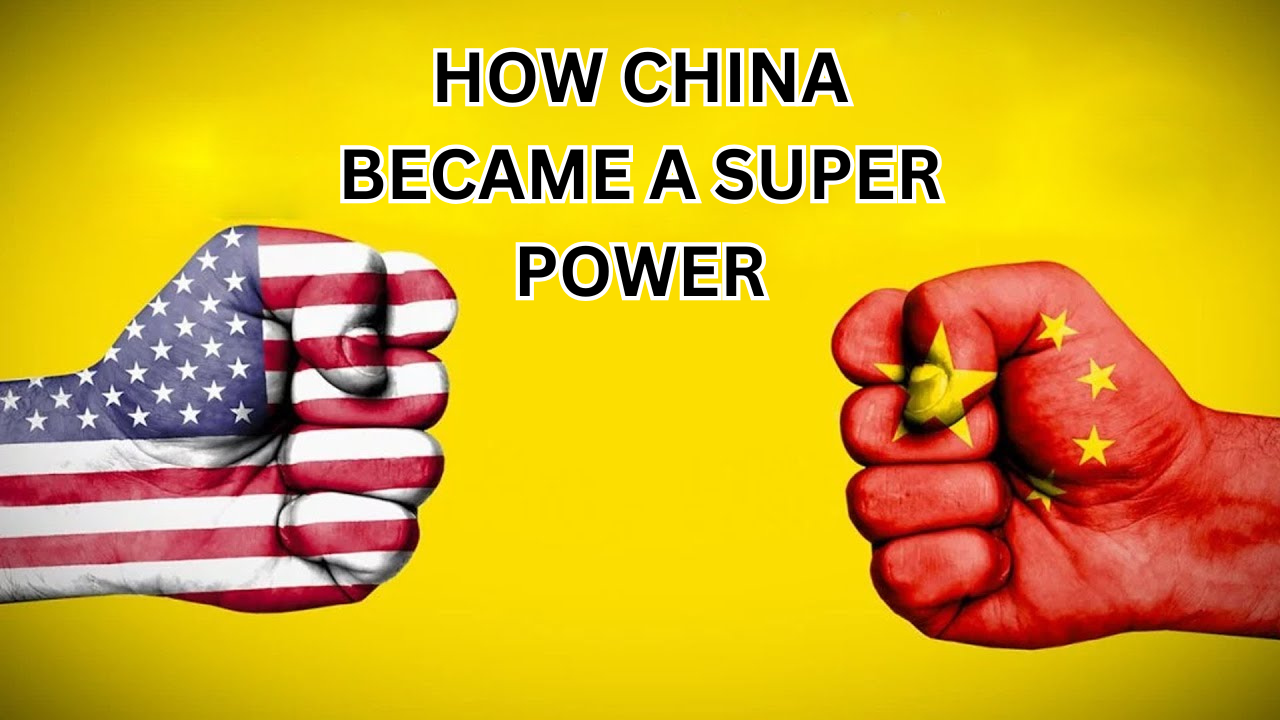China’s rise to superpower status is a remarkable journey marked by dramatic economic growth technological advancements and an increasingly influential global presence from the late 20th century to today china has transformed from an impoverished isolated nation into one of the world leading economic powers the key to this transformation lies in a series of strategic reforms that began in the late 1970s under the leadership of Deng Xiaoping his decision to open up China economy embrace market-oriented policies and encourage foreign investment set the stage for rapid industrialization this economic boom was coupled with significant investments in education infrastructure and technology.
China to evolve into a manufacturing hub for the world as the country expanded its influence in global trade it also bolstered its military strength and technological prowess with a population of over 1.4 billion china became an economic powerhouse and an indispensable player on the world stage china growing political and economic clout affects everything from global trade policies to technological innovation the country transformation is not just about wealth but also about its ambition to reshape global dynamics and establish itself as a dominant superpower in the 21st century.
Economic Reforms (1978-1992):
Between 1978 and 1992 china underwent a series of groundbreaking economic reforms that laid the foundation for its transformation into a global powerhouse under the leadership of Deng Xiaoping china shifted away from its traditional state-controlled economic policies and embraced market-oriented reforms the turning point came with the introduction of the Open Door policy which encouraged foreign trade and investment opening china to the global market one of the most significant changes was the move toward a socialist market economy where private enterprise was allowed to grow alongside state-owned enterprises the government decollectivized agriculture giving farmers more control over their land and production.
Special Economic Zones (SEZ) were established in cities like Shenzhen where foreign businesses could operate with fewer restrictions attracting investment and boosting the country industrial sector these zones became models for China economic modernization the reforms also spurred rapid urbanization as millions of people moved from rural areas to cities in search of better jobs china economy grew at an extraordinary rate lifting millions out of poverty and positioning the country as an emerging global economic player this period of economic reform marked a crucial shift in China path toward becoming one of the world largest and most influential economies.
Rapid Industrialization (1992-2001):
From 1992 to 2001, china experienced a phase of rapid industrialization that dramatically transformed its economy and global standing after the success of earlier economic reforms Deng Xiaoping southern tour in 1992 gave a strong push for further market-oriented policies leading to a new wave of industrial growth china began shifting its focus from agriculture to manufacturing rapidly becoming the world factory the government invested heavily in infrastructure building modern roads railways and ports to connect cities and facilitate the movement of goods this enabled industries to thrive especially in areas like electronics, textiles and machinery during this time china also became a major player in global trade.
The country entry into the world trade Organization (WTO) in 2001 was a milestone opening up even more international markets for Chinese goods with an abundant labor force willing to work for lower wages china attracted foreign companies looking for cost-effective manufacturing solutions china industrial output turning the nation into the world largest producer and exporter of goods the period also saw a rise in urbanization with cities like Shanghai and Beijing rapidly growing as centers of industry and innovation this era of industrialization played a crucial role in lifting millions of people out of poverty creating a large middle class and establishing China as a dominant force in the global economy.
Global Integration (2001-2010):
The period from 2001 to 2010 marked a significant era of global integration where countries cultures and economies became more interconnected than ever before technological advancements particularly the rise of the internet and communication tools played a pivotal role in breaking down geographical barriers the spread of the internet along with social media platforms allowed for the rapid exchange of ideas information and cultures making the world feel smaller and more accessible economically, globalization surged as multinational companies expanded their reach and international trade grew at an unprecedented rate.
This era also saw an increase in international cooperation in various sectors such as education healthcare and environmental initiatives as countries recognized the importance of working together to address global challenges this period was not without its challenges while global integration brought benefits like economic growth and cultural exchange it also highlighted issues such as income inequality cultural homogenization and environmental concerns these challenges the first decade of the 21st century set the stage for even greater global connectivity laying the foundation for the future of a more interconnected world.
Belt and Road Initiative (BRI) and Global Leadership (2015-Present):
Since its launch in 2015, China Belt and Road Initiative (BRI) has become a major force in reshaping global leadership and international relations the BRI aims to enhance trade and investment connections between Asia Africa and Europe by building infrastructure such as roads, ports, and railways, fostering economic development across numerous countries through this ambitious project china has positioned itself as a key global leader influencing global trade routes and offering financial support to developing nations the BRI has created new opportunities for growth in countries that may have been overlooked by traditional Western investors.
It also brought new partnerships between China and other governments this global leadership has sparked debates with critics raising concerns about the potential for debt traps in partner countries and the growing influence of China in international politics these concerns the BRI continues to grow and shape the global landscape with China at the center of this new wave of economic and geopolitical influence illustrating how global leadership can evolve in the modern world.
